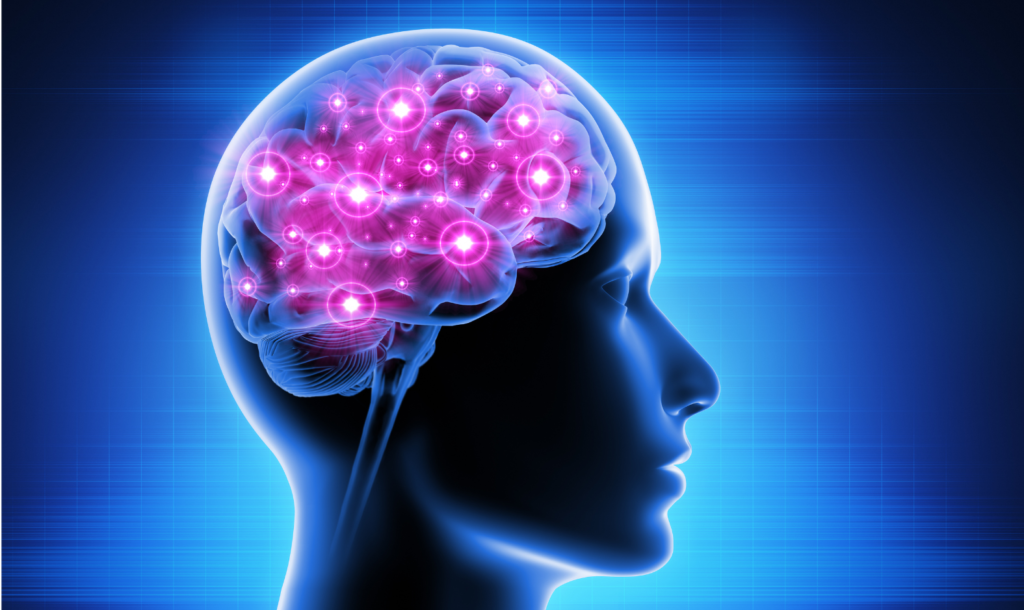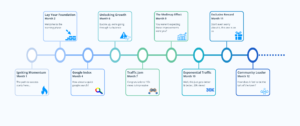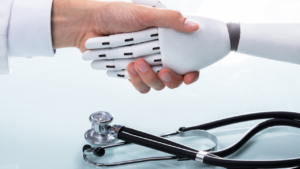- January 2, 2022
- Chris Lamb
Share this article
Share on linkedin
Share on twitter
Share on facebook
Share on email
What is Neuroplasticity and Motor Imagery? Part 1
This article was written by Chris Lamb, Registered Physiotherapist from Dockside Physiotherapy.
Neuroplasticity refers to the changes that happen in the brain and nervous system as a result of life experience. It is primarily expressed as a change in the connectional strength between nerve cells (*the area between nerve cells is called the synapse (see below for a picture of a synapse)); the connections can become weaker or stronger, and the number of nerve cells dedicated to supporting a behavior (e.g. certain movements) may increase or decrease.
For example, if you practiced a certain set of dance moves, the areas of your brain responsible for this dance sequence (e.g. motor areas, sensory areas, balance areas, etc.) would increase the number and strength of connections of nerve cells supporting this behaviour — and it would become much easier to perform this set of actions.
Conversely, if you stop practicing these dance moves over weeks and months, the areas of your brain responsible for this dance sequence would decrease the number and strength of connections of nerve cells supporting this behaviour (and it would be much harder to perform this set of actions). The same is true of pain; the more it is reinforced, the stronger the network for pain becomes (it is like adding more logs to a pre-existing fire). The less it is reinforced, the weaker this network becomes (you don’t add any more logs to the fire and it eventually burns out). Whatever pattern, or set of patterns you practice (it doesn’t matter what it is — whether it is dancing, playing the piano, balancing on a tightrope, swinging a golf club, anxiety, pain, etc.) – they become stronger every time it is repeated. In other words, the more it is reinforced, the stronger it becomes.
The diagram below illustrates some of the changes that happen at the synapse with continued reinforcement (don’t worry about the details!).

Humans have about 80-100 billion nerve cells, and there are approximately 60-240 trillion possible connections between these nerve cells. These connections are constantly changing based on our experience; our capacity for change is astounding (and this change is possible throughout our whole lives!)
Neuroplasticity is not good or bad; it is an inherent property of how the brain operates. Learning can be positive (e.g. playing the piano) or negative (e.g. pain) – and the same principles governing neuroplasticity change work whether it is something desirable or undesirable. *We always have the capacity to change pre-existing patterns, but the more something has been reinforced, and the longer it has been reinforced, the more resistant to change it becomes — and much more work will be required to change it. For example, if you have been having constant back pain for 10 years, it will take a lot more work to break this pattern compared with someone who has been having the odd, short-lived bout of back pain over a period of 6 months.
Another very important principle of how neuroplasticity works is “nerves that fire together, wire together.” See below for a technical explanation by Merzenich, Van Vleet, and Nahum (2014), followed by a more simplistic one (skip the next two paragraphs if you are not interested in learning the finer details):
“Plasticity is primarily expressed by a change in connectional strength at the synapse level, achieved both by increasing the powers and the numbers of synapses specifically supporting a behavior. Processes that control plasticity strengthen all synapses that are activated together at each brief moment in time that has contributed to the just-past behavior. The great principle postulated by the Canadian psychologist Donald Hebb (1949) applies: “What fires together wires together.”
Through Hebbian network plasticity, the extensively cross-wired neurons in the cerebral cortex also strengthen their connections with their nearest neighbors. When the brain is engaged behaviorally, inputs that are activated nearly simultaneous in time strengthen together, increasing their cooperativity to generate more salient (i.e., more powerful and more reliable) responses.”1
What this basically means is that when two things repetitively happen close in time, the more likely they are going to happen together in the future (and it becomes harder and harder to do one without the other). The more frequently they are activated together, the stronger the connection becomes; this is called associative learning and is foundational to how we learn anything. For example, if someone has chronic lower back pain and repeatedly has pain when they try to bend forwards in standing, the more the pain accompanies the movement pattern of bending forwards, the stronger the neurological “association” becomes — and it will become increasingly difficult to bend forwards without the associated painful response. This can occur with anything (e.g. sitting for a period of time and increased pain, walking for a period of time and increased pain, etc.) Similarly, certain cues within the environment (e.g. sights, sounds, smells, certain people, etc.) can also become “associated” with pain if repeatedly reinforced together. When some people go to a completely novel environment (e.g. Hawaii) where the sights, sounds, smells, people, etc. are very different from what they normally encounter, they can become completely pain-free or have their pain significantly diminished (but immediately returns when they come home). As depicted in the graph below, most of this processing/learning is below the level of our conscious awareness – which is why telling ourselves that something should or shouldn’t be happening rarely works.
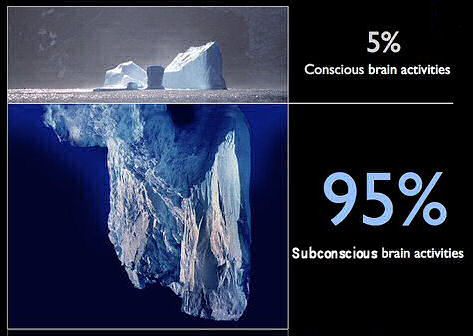
In contrast, “nerves that fire apart, wire apart.” If you can somehow learn to do the activity without the associated response (e.g. bending forwards while pain-free, sitting for a period of time without the associated painful response, etc.), the weaker the connections become (i.e. the strength of the connection between nerve cells). In other words, the less they are activated together, the less likely they are to activate together in the future (e.g. you could bend forwards more and more easily without the associated painful response, sit for longer periods without the associated painful response, etc.).
Another very important principle of neuroplasticity is that “the brain is changed by internal mental rehearsal in the same ways and involving precisely the same processes that control changes achieved through interactions with the external world.”2
What this means is that when you imagine/visualize doing something, the brain responds in a very similar way (and can drive the same neuroplastic changes) to when you actually do something. For example, when you imagine listening to music, the auditory areas in your brain will activate in a very similar way compared to actually listening to music. In a similar vein, when you imagine bending forwards in standing, the sensory-motor areas in your brain will activate in a very similar way compared to actually bending forwards in standing.
To illustrate this point, look at the picture below; focus on the image on the left in red (this is the primary motor cortex, which is responsible for the “execution” of movement). Notice how each part of the body has a variable representation; areas that have finer degrees of control (e.g. the hands, face, tongue) have a larger representation (i.e. more nerve cells and connections dedicated to producing movement in these body parts). As previously noted, these “representations” are constantly changing based on our experience. For example, if you become a professional violinist, the area representing the hands would significantly enlarge and become very detailed. Conversely, if you put oven mitts on your hands and never took them off, the area representing the hands would shrink considerably and become less and less detailed. In short, this demonstrates the “use it or lose it” principle of neuroplasticity.
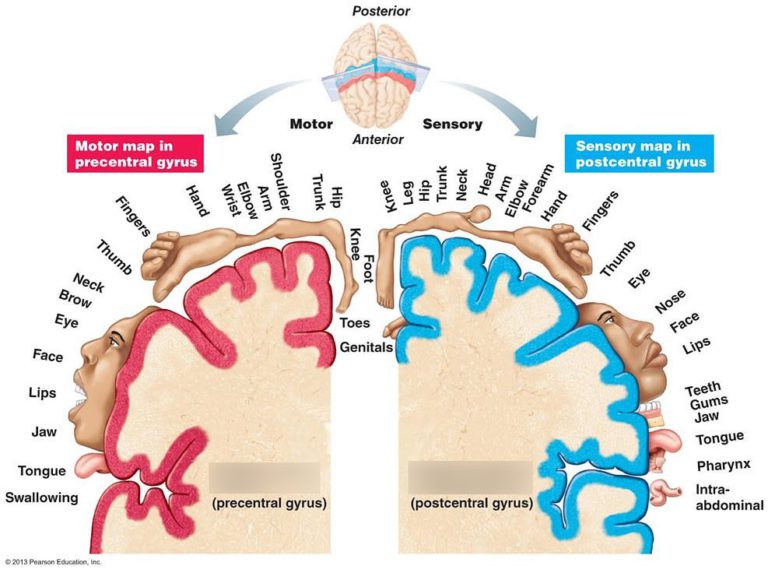
The below graph is taken from a study performed in 1995; participants were divided into 3 groups. The first group performed actual movement sequences of the fingers on a piano, the second group imagined the exact same sequences (without any movement), and the third group did nothing (as a control). The researchers were measuring the size of the primary motor cortex representing the fingers (as shown above), before and after the actual and imagined movements; the two active groups practiced for 2 hours daily, for a total of five consecutive days. As you can see in the two active groups, each day showed enlargement of the finger representation (the little black and grey circles represent the fingers) in the primary motor cortex; *the changes seen were very similar in the imagery group compared to the actual practice group (compared to no changes seen in the control group). This study has been replicated many times since.
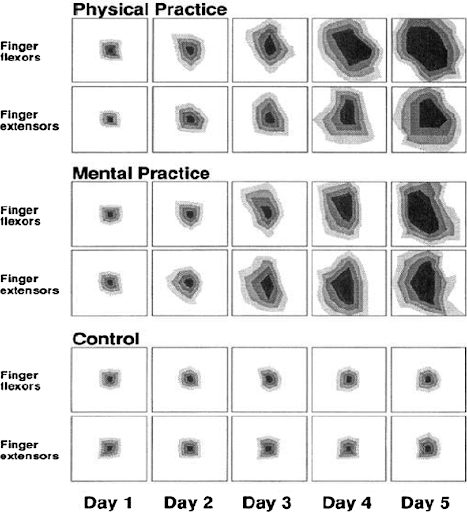
M1 plasticity after mental practice measured by TMS. After physical and mental practice of finger-sequence task, the authors observed a larger cortical map representing the long finger
flexor and extensor muscles in contralateral M1 (courtesy of Pascual-Leone et al. (1995)).
Remember, movement patterns can become “wired” with painful responses (“nerves that fire together, wire together”). Movement patterns, however, can be activated in the brain using motor imagery, and “unwired” from the painful/symptomatic response (“nerves that fire apart, wire apart”).
Discover the benefits of motor imagery with a qualified physiotherapist. Book an appointment now on medimap.ca.
There are many different types of motor imagery that can be used. Each type of motor imagery involves varying degrees and magnitude of brain activation. Depending on how “sensitive” an individual’s system is, even imagining movement can provoke pain/symptoms (*remember, “nerves that wire together, fire together) – and the greater degree of brain activation in the motor/sensory areas, the greater the likelihood of a symptomatic response (*remember, the brain doesn’t differentiate between real and imagined movements). Therefore, it is important to start with a level of motor imagery that does not provoke an increase in symptoms (ideally at the threshold just below the symptomatic responses).
Quotations:
1) Nahum M, Lee H, and Merzenich M. Chapter 6 – Principles of neuroplasticity-based rehabilitation. Prog. Brain Res. 2013;207:141-173.
2) Merzenich M. Soft-wired: How the new science of brain plasticity can change your life. 2nd edition. Berkeley: Parnassus Press; 2013.
To learn more about health providers in your area or to ask about providers who address specific treatment needs, contact us today.
About the author

Chris Lamb
Chris has been a registered physiotherapist since 2006 and has extensive experience helping people with orthopedic and/or neurological injuries and conditions. He has worked in both private clinic and community settings, and has taught numerous courses on topics such as pain science and treatment, neuroscience and neuroplasticity, and mindfulness meditation. Over the past few years, he worked with a neurologist weekly co-teaching classes to his patients. Chris is also currently involved in research projects on motor imagery in persistent pain and neurological conditions.
-
Chris Lambhttps://medimap.ca/author/chris-lamb/
